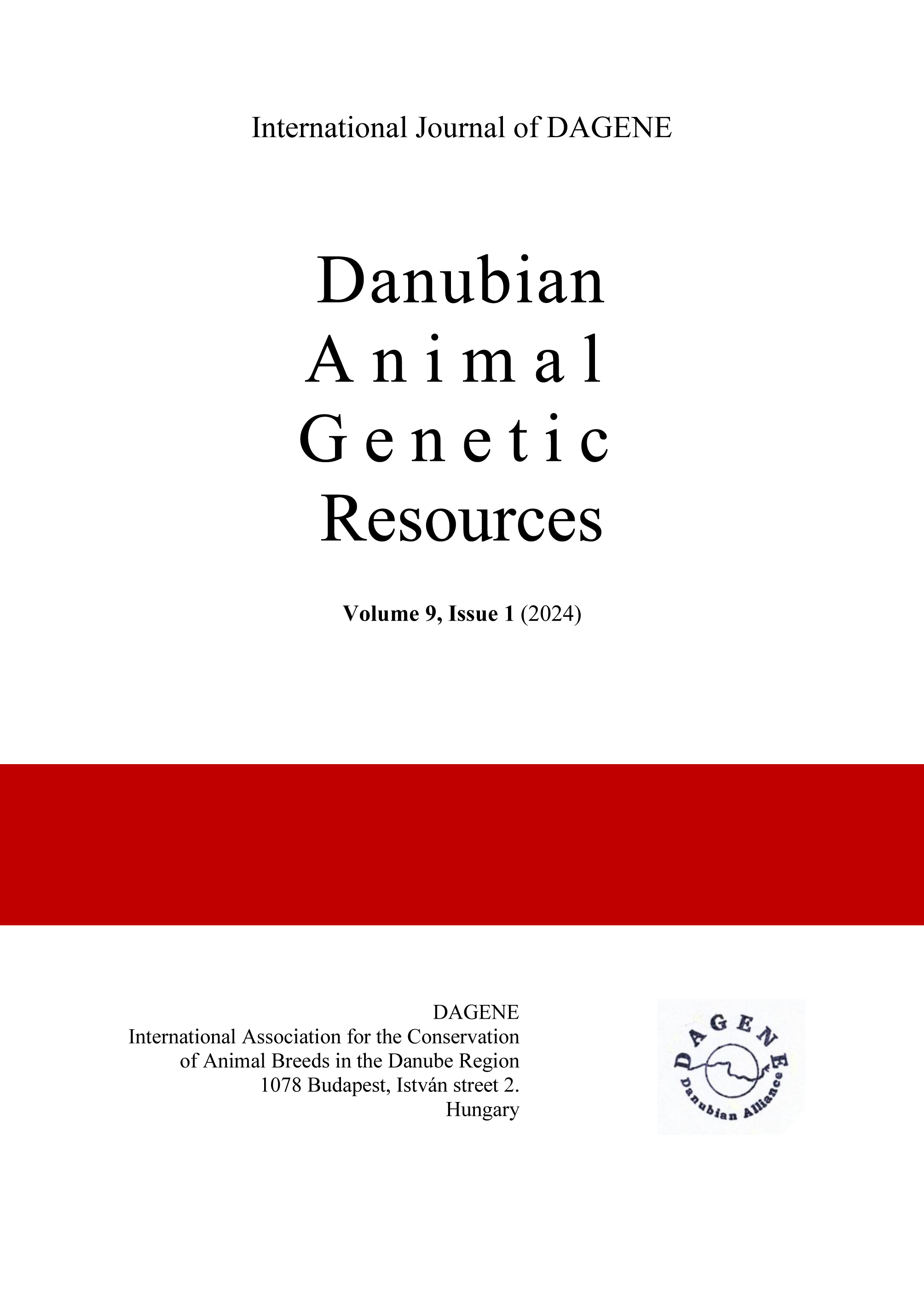Cryopreserved Sperm Quality in Tsigai Sheep: Implications for Biodiversity Protection
Abstract
The objective of our research was to conduct a comparative analysis of cryopreserved sperm quality parameters of Tsigai (TS) sheep breed. Ejaculates (n=12) from TS sheep rams (n = 2) were collected using electro-ejaculation. Samples were prepared from suitable ejaculates, ensuring at least 70% progressive motility. These samples were then equilibrated in Triladyl® diluent and subjected to automated freezing. Before freezing and after thawing, the sperm samples underwent assessments including motility (CASA), viability and apoptosis (DRAQ7/Yo-Pro-1), mitochondrial activity (MitoTracker), capacitation status (FLUO4), and acrosomal status (PNA). The results revealed significant differences (P < 0.05) in total motility between fresh (91.25±0.80 %) and frozen/thawed (F/T) (41.14±12.04 %) samples, as well as progressive motility between fresh (89.83±1.85 %) and frozen/thawed (33.57±8.25 %) groups. Moreover, significant differences (P<0.05) were also observed in the proportion of apoptotic spermatozoa (2.26±0.60 %), dead (7.40±1.72 %), and mitochondrial active spermatozoa (84.52±5.60 %) in fresh samples compared to F/T samples (12.34±0.80 %, 46.59±2.82 %, 47.71±4.04 %). Our findings indicate that the selected cryopreservation protocol is relatively sufficient for the cryoconservation of sperm from Tsigai sheep breeds, since up to 50% of F/T sperm were motile and live. This has significant implications for biodiversity protection and simplifies the establishment of an animal genetic resources gene bank.
References
BARBAS, J.P. – MASCARENHAS, R.D. (2009): Cryopreservation of Domestic Animal Sperm Cells. Cell Tissue Bank. 10: 49–62.
BARILLET, F. (2007): Genetic improvement for dairy production in sheep and goats. Small Ruminant Research, 70(1): 60-75. https://doi.org/10.1016/j.smallrumres.2007.01.004
FAO. 2008. Subject: FAO statistics. http://www.fao.org./DOCREP/U5700T/U5700TOM.HTM. Accessed September 2008.
GALARZA, D.A. – LÓPEZ-SEBASTIÁN, A. – WOELDERS, H. – BLESBOIS, E. – SANTIAGO-MORENO, J. (2019): Two-Step Accelerating Freezing Protocol Yields a Better Motility, Membranes and DNA Integrities of Thawed Ram Sperm than Three-Steps Freezing Protocols. Cryobiology 91: 84–89. https://doi.org/10.1016/j.cryobiol.2019.10.007
GÁSPÁRDY, A. – RENKÓ, E. – SOMOSKŐI, B. – BÁBA, A. – CSEH, S. (2020): Practical Experience with Artificial Insemination (AI) Using Fresh Chilled and Frozen Semen in Mares. Acta Vet. Hung. 68: 85–90. https://doi.org/10.1556/004.2020.00007
JIMÉNEZ-RABADÁN, P. – SOLER, A.J. – RAMÓN, M. – GARCÍA-ÁLVAREZ, O. – MAROTO-MORALES, A. – INIESTA-CUERDA, M. – FERNÁNDEZ-SANTOS, M.R. – MONTORO, V. – PÉREZ-GUZMÁN, M.D. – GARDE, J.J. (2016): Influence of Semen Collection Method on Sperm Cryoresistance in Small Ruminants. Anim. Reprod. Sci., 167: 103–108. https://doi.org/10.1016/j.anireprosci.2016.02.013
JOOST, S. – BRUFORD, M.W. (2015): The Genomic-Resources Consortium Editorial: Advances in Farm Animal Genomic Resources. Front. Genet. 6: 333. https://doi.org/10.3389/fgene.2015.00333
KUMARESAN, A. – ELANGO, K. – DATTA, T.K. – MORRELL, J.M. (2021): Cellular and Molecular Insights Into the Etiology of Subfertility/Infertility in Crossbred Bulls (Bos taurus × Bos indicus): A Review. Front. Cell Dev. Biol. 9: 696637. https://doi.org/10.3389/fcell.2021.696637
LEGARRA, A. – RAMÓN, M. – UGARTE, E. – PÉREZ-GUZMÁN, M.D. (2007): Economic weights of fertility, prolificacy, milk yield and longevity in dairy sheep. Animal, 1(2): 193-203. https://doi.org/10.1017/S1751731107657814
ORAVCOVÁ, M. – GROENEVELD, E. – KOVAČ, M. – PEŠKOVIČOVÁ, D. – MARGETIN, M. (2005): Estimation of genetic and environmental parameters of milk production traits in Slovak purebred sheep using test-day model. Small Ruminant Research, 56(1-3): 113-120. https://doi.org/10.1016/j.smallrumres.2004.03.002
PERIS-FRAU, P. – MARTÍN-MAESTRO, A. – INIESTA-CUERDA, M. – SÁNCHEZ-AJOFRÍN, I. – MATEOS-HERNÁNDEZ, L. – GARDE, J.J. – VILLAR, M. – SOLER, A.J. (2019): Freezing–Thawing Procedures Remodel the Proteome of Ram Sperm before and after In Vitro Capacitation. Int. J. Mol. Sci. 20: 4596. https://doi.org/10.3390/ijms20184596
PS SR. 2009. Subject: Plemenárske služby Slovenskej republiky, š. p. http://www.pssr.sk/download/ovkz/plem2006.pdf. Accessed April 2009.
RAKHA, B.A. – ANSARI, M.S. – AKHTER, S. – HUSSAIN, I. – BLESBOIS, E. (2016): Cryopreservation of Indian Red Jungle Fowl (Gallus gallus murghi) Semen. Anim. Reprod. Sci. 174: 45–55. https://doi.org/10.1016/j.anireprosci.2016.09.004
RASPA, M. – GUAN, M. – MONTOLIU, L. – AYADI, A. – MARSCHALL, S. – FRAY, M. – SCAVIZZI, F. (2017): Dry Ice Is a Reliable Substrate for the Distribution of Frozen Mouse Spermatozoa: A Multi-Centric Study. Theriogenology, 96: 49–57. https://doi.org/10.1016/j.theriogenology.2017.04.003
SILVA, S. – SOARES, A. – BATISTA, A. – ALMEIDA, F. – NUNES, J. – PEIXOTO, C. – GUERRA, M. (2011): In Vitro and In Vivo Evaluation of Ram Sperm Frozen in Tris Egg-Yolk and Supplemented with Superoxide Dismutase and Reduced Glutathione. Reprod. Domest. Anim., 46: 874–881. https://doi.org/10.1111/j.1439-0531.2011.01758.x
SMULDERS, J. P. – SERRANO, M. - PÉREZ-GUZMÁN, M. D. – JIMENEZ, M.A. – URIBE, H. – JURADO, J.J. (2007): Stochastic simulation of Manchega sheep breed selection scheme. Impact of artificial insemination, progeny testing system and nucleus size on genetic progress and inbreeding. Livestock Science, 106(2-3): 218-231. https://doi.org/10.1016/j.livsci.2006.08.008
SVORADOVÁ, A. – KUŽELOVÁ, L. – VAŠÍČEK, J. – OLEXÍKOVÁ, L. – CHRENEK, P. (2018): Cryopreservation of Chicken Blastodermal Cells and Their Quality Assessment by Flow Cytometry and Transmission Electron Microscopy. Biotechnol. Prog. 34: 778–783. https://doi.org/10.1002/btpr.2615
VOZAF, J. – MAKAREVICH, A.V. – BALAZI, A. – VAŠÍČEK, J. – SVORADOVA, A. – OLEXIKOVA, L. – CHRENEK, P. (2021): Cryopreservation of Ram Semen: Manual versus Programmable Freezing and Different Lengths of Equilibration. Anim. Sci. J. 92: e13670. https://doi.org/10.1111/asj.13670



